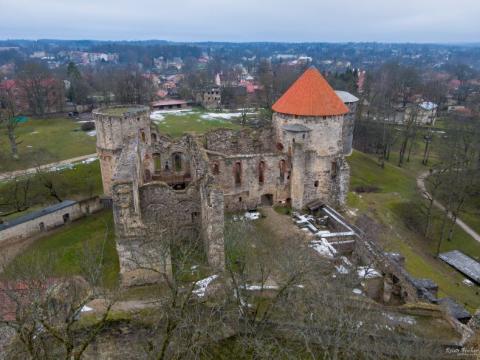Cēsis Castle is one of the most iconic and best-preserved medieval castles in Latvia.
The foundations of the castle were laid 800 years ago by the Livonian Brothers of the Sword. The most prosperous period Cēsis Castle experienced was during its next owners, the Teutonic Order. It became one of the key administrative and economic centers of the Teutonic Order in Livonia and was a seat of Landmeister in Livland.
The first serious damage was done to the castle during the Livonian War, when it was besieged by the army of Ivan the Terrible. In the course of the siege of 1577 approximately 300 people within the castle committed mass suicide by blowing themselves up with gunpowder. Cēsis Castle was still in use during the following century but it fell into disuse after the Great Northern War. Today the castle is the most visited heritage site in Cēsis and one of the 'must see' destinations in the Baltic states.

Cēsis Castle from a drone flight
It was on January 2, 2021 we took our rental car from Riga and visited both Cēsis and Valmiera, with one of our stops at Cēsis Castle
Cēsis Castle is open to the public year-round and according to figures released by Cēsis Culture and Tourism Centre, 100 000 people visited the castle in 2016.
The main site of interest in the castle – the Western Tower – lures the visitors not only with the Master's Chamber but also with the possibility to get a bird's eye view of the surroundings. The loft windows open to the scenery of the environs of Cēsis in all its glory.

Cēsis Castle form a drone flight
Each visitor is given a candle lantern to explore the dimly lit Western Tower. It is a tradition that originated in 1996 and has become a trademark of Cēsis Castle.
The castle is not only a tourist attraction but also a habitat of various species of plants and animals. Naturalists have drawn special attention to bats, which hibernate i the basements of the castle. When frost sets in, five different species of bats settle in wall cavities and stay there throughout the winter.
Throughout the summer season there are artisan workshops located in the outer bailey of the castle where bone and antler craftsman, woodturner, blacksmith and printmaker work. They practice their craft by utilising the same methods as were common in the Middle Ages.
Adjacent to artisan workshops a 16th-century kitchen garden is recreated. The garden contains vegetables, herbs and medicinal plants that were cultivated in Livonia, 500 years ago. As with artisans, it is possible to meet a gardener every day during the summer season.

